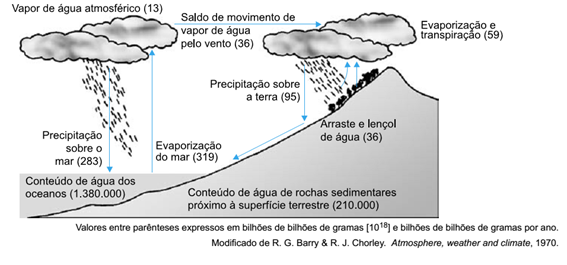O water cycle understands the steps of transforming water in nature through the processes of physical state changes.
We prepare a water cycle exercise list so that you can test your knowledge about the steps of transformation of this fundamental substance for living beings.
You can consult the template and save this exercise list in PDF at the end of the post!
Exercises on the water cycle
1) (UNIFESP) Look at the figure that refers to the water cycle on a global scale.

By analyzing the figure, it can be concluded that the amount of water that evaporates per year from the Earth's surface into the atmosphere is __________ the amount precipitated. The __________ energy from the water promotes its evaporation. Subsequently, the condensation of steam formed __________ the potential energy of water in the form of heat. The __________, not the __________, determines the flow of water through the ecosystem.
In this text, the gaps must be filled, respectively, by:
a) … overcomes … absorbed … absorbs … precipitation … evaporation
b) … overcomes … released … releases … evaporation … precipitation
c) … equals … released … absorbs … precipitation … evaporation
d) … equals … released … releases … precipitation … evaporation
e) … equals … absorbed … releases … evaporation … precipitation
2) (ENEM) The lack of fresh water on the Planet will possibly be one of the most serious problems of this century. It is predicted that, over the next twenty years, the amount of fresh water available to each inhabitant will be drastically reduced. Through their different uses and consumptions, human activities interfere in the water cycle, changing:
a) the total quantity, but not the quality of water available on the Planet.
b) the quality of water and its quantity available for consumption by populations.
c) the quality of available water, only in the terrestrial subsoil.
d) only the availability of surface water existing in rivers and lakes.
e) the rainfall regime, but not the amount of water available on the Planet.
3) During the water cycle, we observe the formation of clouds, which occurs thanks to the transformation of water vapor into small droplets. This change from gas to liquid is called:
a) evaporation.
b) solidification.
c) sublimation.
d) merger.
e) condensation.
4) (UFRGS) Check the alternative that correctly fills in the blanks in the following statement, in the order in which they appear.
Urbanization promotes changes in the hydrological cycle by reducing soil infiltration. The volume of water that fails to infiltrate remains on the surface, __________ surface runoff. The maximum flows __________. With the reduction of infiltration, __________ the level of the water table.
a) increasing - increasing - decreasing
b) increasing – increasing – increasing
c) decreasing – decrease – decrease
d) decreasing – increasing – decreasing
e) increasing – decreasing – increasing
5) Biogeochemical cycles can be defined as processes in which chemical elements circulate between living beings and the environment. The water cycle is no different and living beings actively interfere in the cyclical movement of this molecule.
Mark the alternative that correctly indicates the name of the process characterized by the loss of water by the plants in the form of steam.
a) Breathing.
b) Perspiration.
c) Photosynthesis.
d) Guttation.
- Free Online Inclusive Education Course
- Free Online Toy Library and Learning Course
- Free Online Preschool Math Games Course
- Free Online Pedagogical Cultural Workshops Course
6) The water cycle occurs thanks to changes in the physical state of this substance. Among the processes listed below, mark the one that correctly indicates the name of the change that takes place at the time of cloud formation.
a) Evaporation.
b) Sublimation.
c) Fusion.
d) Condensation.
e) Vaporization.
7) (ENEM) The sun participates in the water cycle, as in addition to heating the Earth's surface giving rise to winds, it causes the evaporation of water from rivers, lakes and seas. When water vapor cools, it condenses into tiny droplets, which gather together to form clouds, mists or moist mists. Clouds can be carried by the winds from one region to another. With condensation and then rain, water returns to the Earth's surface, falling onto soil, rivers, lakes and seas. Part of this water evaporates returning to the atmosphere, another part runs off superficially or infiltrates the ground, feeding rivers and lakes. This process is called the water cycle.
Then consider the following statements:
I – Evaporation is greater on the continents, since the warming is greater there than in the oceans.
II – Vegetation participates in the hydrological cycle through transpiration.
III – The hydrological cycle conditions processes that occur in the lithosphere, atmosphere and biosphere.
IV – Gravitational energy moves water within its cycle.
V – The hydrological cycle is susceptible to human interference, and may present imbalances.
Check the appropriate alternative:
a) only statement III is correct.
b) only statements III and IV are correct
c) only statements I, II and V are correct.
d) only statements II, III, IV and V are correct.
e) all statements are correct.
8) (FESP PE) All living beings somehow and constantly participate in the water cycle in nature why consume water from the environment and release it later as a result of their vital activities. Tick:
a) if the statement and the reason are correct.
b) if the statement is correct and the reason is wrong.
c) if the statement is wrong and the reason is correct.
d) if the statement and the reason are wrong.
e) if the statement and the reason are correct, but the reason does not justify the statement.
9) Animals and plants are highly dependent on the water cycle, since this substance is essential for their metabolism. Animals, in addition to using water, also lose this substance to the environment. Among the alternatives below, check the only one that does not refer to a way for animals to eliminate water into the environment.
a) Elimination of urine.
b) Elimination of feces.
c) Breathing.
d) Perspiration.
e) Guttation.
10) (ENEM) The water cycle is fundamental for the preservation of life on the planet. The Earth's climatic conditions allow water to undergo phase changes and understanding these transformations is fundamental to understanding the hydrological cycle. In one of these changes, water or moisture from the earth absorbs heat from the sun and its surroundings. When enough heat has been absorbed, some of the liquid's molecules may have the energy needed to start rising into the atmosphere. Available in: http://keroagua.blogspot.com. Accessed on: 30 mar. 2009. Adapted.
The transformation mentioned in the text is:
a) merger.
b) liquefaction.
c) evaporation.
d) solidification.
Template
1 and
2 - b
3 - and
4 - the
5 - b
6 - d
7 - d
8 - the
9 and
10 - c
Click here to save this exercise list to PDF!
See too:
- List of exercises on vitamins
- List of exercises on xylem and phloem
- Skin Exercises List
The password has been sent to your email.

